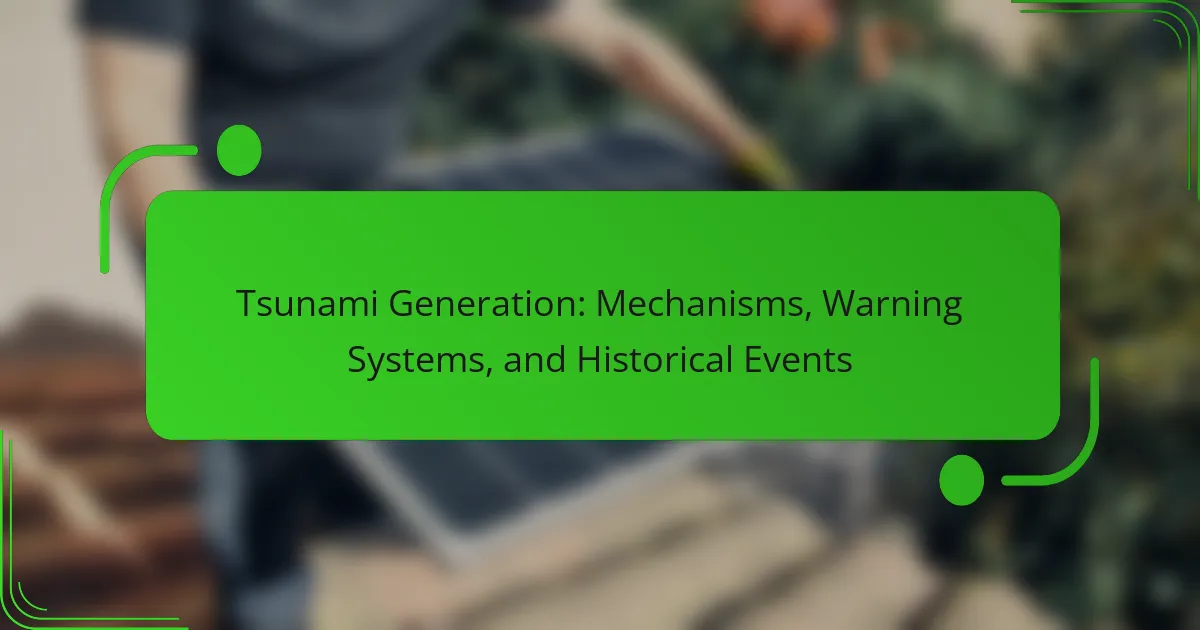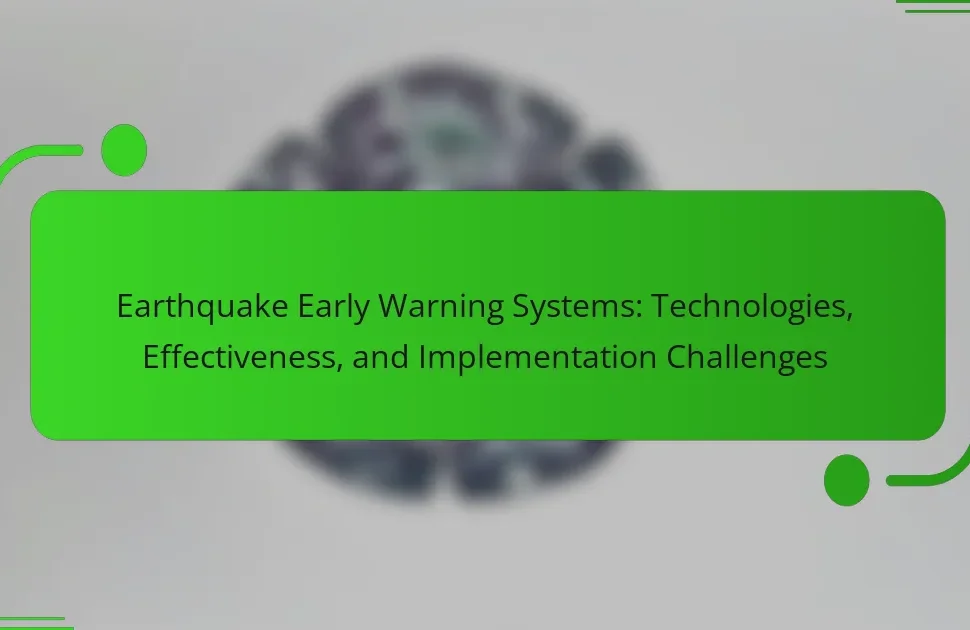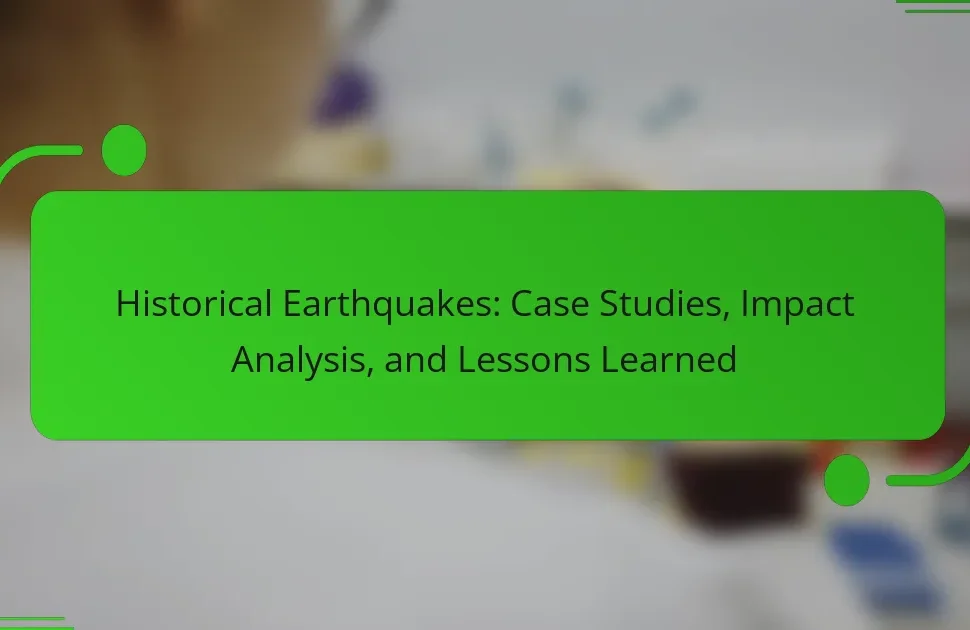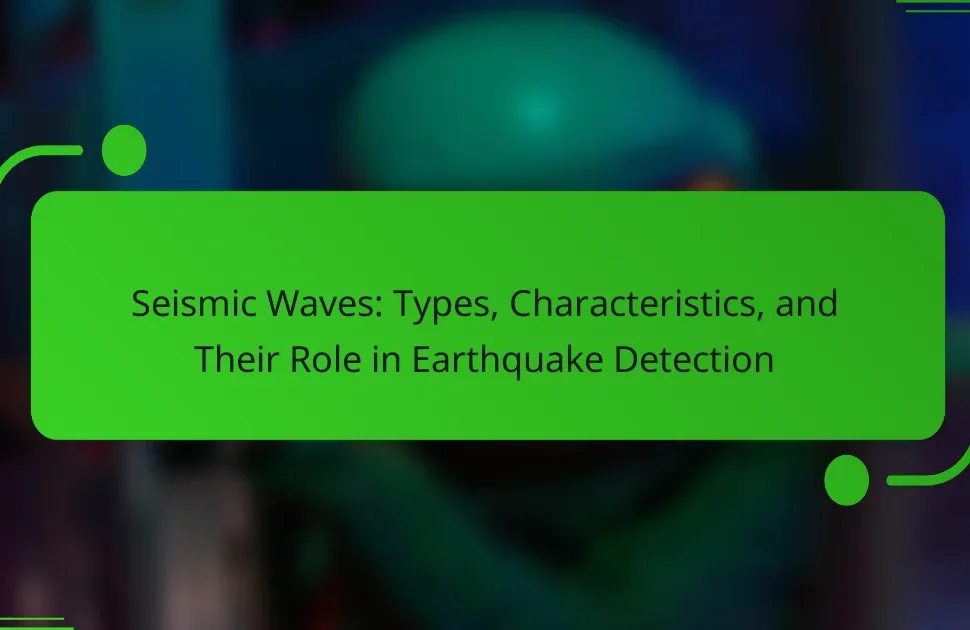Tsunamis are large ocean waves primarily generated by underwater disturbances such as earthquakes, volcanic eruptions, and landslides, with seismic activity along tectonic plate boundaries being the most common cause. The article explores the mechanisms of tsunami generation, detailing how significant seismic events can displace vast volumes of water, leading to destructive waves. It also examines tsunami warning systems, which utilize seismic monitoring, ocean buoys, and public alert systems to provide timely alerts and reduce casualties. Additionally, the article highlights key historical events, including the 2004 Indian Ocean tsunami and the 2011 Tōhoku earthquake, which have shaped our understanding of tsunamis and emphasized the importance of preparedness and international collaboration in tsunami research.
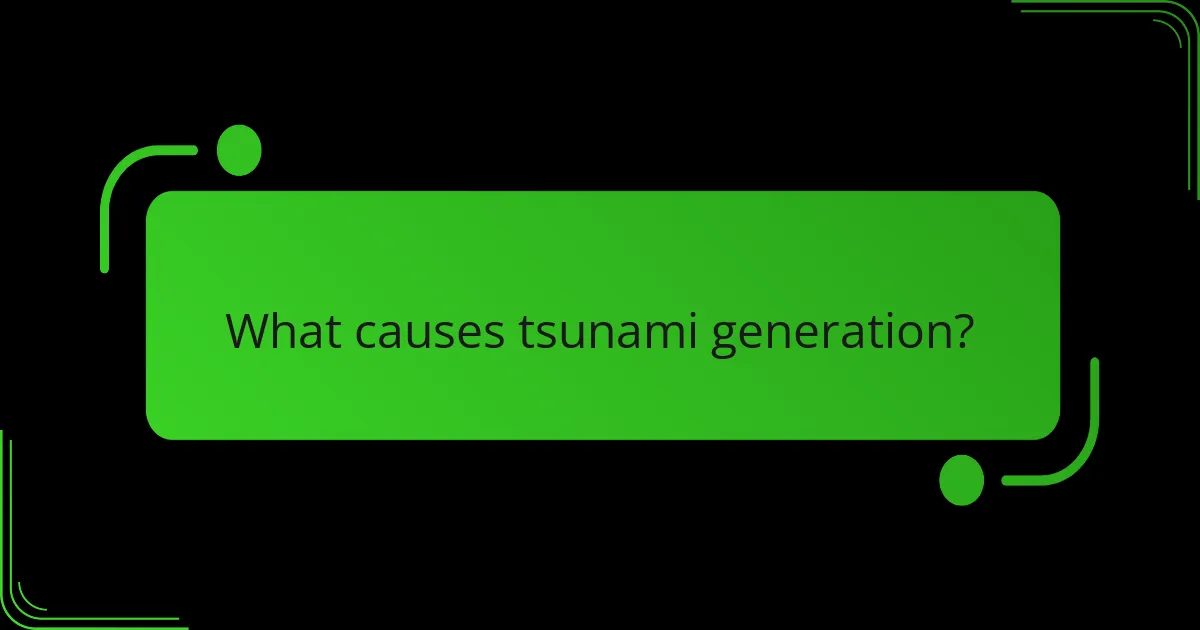
What causes tsunami generation?
Tsunamis are generated primarily by underwater disturbances. These disturbances can include earthquakes, volcanic eruptions, and landslides. Most tsunamis are caused by seismic activity along tectonic plate boundaries. When an earthquake occurs, it can displace a large volume of water. This displacement generates waves that travel across the ocean. The 2004 Indian Ocean tsunami, for example, was triggered by a magnitude 9.1 earthquake. Other causes, like volcanic eruptions, can also lead to significant water displacement. Tsunami waves can reach heights of over 100 feet when they approach shorelines.
How do geological events lead to tsunamis?
Geological events lead to tsunamis primarily through underwater earthquakes, volcanic eruptions, and landslides. These events displace large volumes of water, generating powerful waves. Underwater earthquakes, particularly those along tectonic plate boundaries, are the most common cause. The sudden release of energy during an earthquake causes the seafloor to uplift or drop. This vertical displacement of the seafloor creates waves that travel across the ocean.
Volcanic eruptions can also trigger tsunamis when explosive activity displaces water. For example, the 1883 eruption of Krakatoa generated massive waves. Landslides, both underwater and from coastal regions, can similarly displace water and create tsunamis. The energy from these geological events can result in waves reaching heights of over 100 feet.
Historical data shows that significant tsunamis have been linked to geological events, such as the 2004 Indian Ocean tsunami, which resulted from a magnitude 9.1 earthquake. This earthquake displaced the ocean floor and generated waves that impacted multiple countries.
What role do underwater earthquakes play in tsunami formation?
Underwater earthquakes are a primary cause of tsunami formation. These seismic events displace large volumes of water, generating powerful waves. The ocean floor shifts suddenly during an earthquake, creating an upward or downward motion. This movement transfers energy to the water above, forming tsunamis. Historical evidence shows that significant underwater earthquakes have triggered devastating tsunamis. For example, the 2004 Indian Ocean earthquake resulted in tsunamis that affected multiple countries, causing widespread destruction. The magnitude and depth of the earthquake influence the tsunami’s size and impact. Thus, underwater earthquakes play a critical role in the initiation of tsunamis.
How can volcanic eruptions generate tsunamis?
Volcanic eruptions can generate tsunamis through explosive activity or the collapse of volcanic islands. When a volcano erupts explosively, it can displace large volumes of water. This displacement creates waves that can travel across oceans. Additionally, if a volcanic island collapses into the sea, it can also generate significant waves. Historical events, such as the 1883 Krakatoa eruption, demonstrate this phenomenon. The eruption caused massive tsunamis that affected coastlines thousands of miles away. The energy released during such eruptions is capable of producing waves over 30 meters high. This illustrates how volcanic activity can be a significant source of tsunami generation.
What impact do landslides have on tsunami generation?
Landslides can trigger tsunamis when they occur in or near bodies of water. The sudden displacement of water caused by a landslide generates waves. These waves can travel across the water surface, creating a tsunami. Historical events demonstrate this phenomenon, such as the 1958 Lituya Bay landslide in Alaska. This landslide generated a massive wave that reached heights of 1,720 feet. Such tsunamis can be devastating, impacting coastal communities. Therefore, landslides are significant contributors to tsunami generation under certain conditions.
What are the characteristics of tsunamis?
Tsunamis are large ocean waves caused by underwater disturbances. They typically result from earthquakes, volcanic eruptions, or landslides. Tsunamis can travel at speeds exceeding 500 miles per hour in deep water. Their wave height can increase significantly as they approach coastal areas. In shallow waters, wave heights can exceed 100 feet. Tsunamis can cause widespread destruction upon landfall. The time between waves can vary from minutes to hours. Historical events, such as the 2004 Indian Ocean tsunami, illustrate their devastating impact.
How do tsunami waves differ from regular ocean waves?
Tsunami waves differ from regular ocean waves primarily in their formation and impact. Regular ocean waves are generated by wind and typically have a wavelength of a few hundred meters. In contrast, tsunami waves are caused by underwater disturbances, such as earthquakes or volcanic eruptions, leading to wavelengths that can exceed 100 kilometers.
Regular ocean waves have a height of about 1 to 3 meters, while tsunami waves can reach heights of over 30 meters when they approach land. Additionally, regular waves exhibit a periodic motion, while tsunami waves maintain their energy across vast distances, traveling at speeds of up to 500 to 800 kilometers per hour in deep water.
When tsunami waves reach shallow coastal areas, they compress and increase in height, leading to devastating impacts. This behavior contrasts with regular waves, which break and dissipate energy upon reaching the shore. The 2004 Indian Ocean tsunami serves as a historical example, where waves reached coastal heights of up to 30 meters, causing widespread destruction.
What is the typical speed and height of tsunami waves?
Tsunami waves typically travel at speeds of 500 to 800 kilometers per hour (310 to 500 miles per hour) in open water. Their height can vary significantly, ranging from less than one meter to over 30 meters (98 feet) when they reach the shore. In deep water, tsunami waves are often not visible and can pass unnoticed. As they approach shallow coastal areas, their speed decreases, and their height increases due to the energy being compressed. Historical data shows that the 2004 Indian Ocean tsunami had waves exceeding 30 meters in height. This demonstrates the potential for tsunamis to generate massive waves that can cause extensive damage upon landfall.
How does the ocean floor shape influence tsunami behavior?
The shape of the ocean floor significantly influences tsunami behavior. Variations in bathymetry can alter wave speed and direction. Steep slopes can cause waves to rise quickly, increasing their height. Conversely, gradual slopes may dissipate wave energy, reducing impact. Underwater features like ridges or trenches can redirect tsunamis, affecting coastal areas differently. Historical events demonstrate this; for instance, the 2004 Indian Ocean tsunami’s impact varied due to ocean floor topography. Tsunami modeling incorporates these factors to predict wave behavior accurately. Understanding ocean floor shape is crucial for effective tsunami preparedness and response.
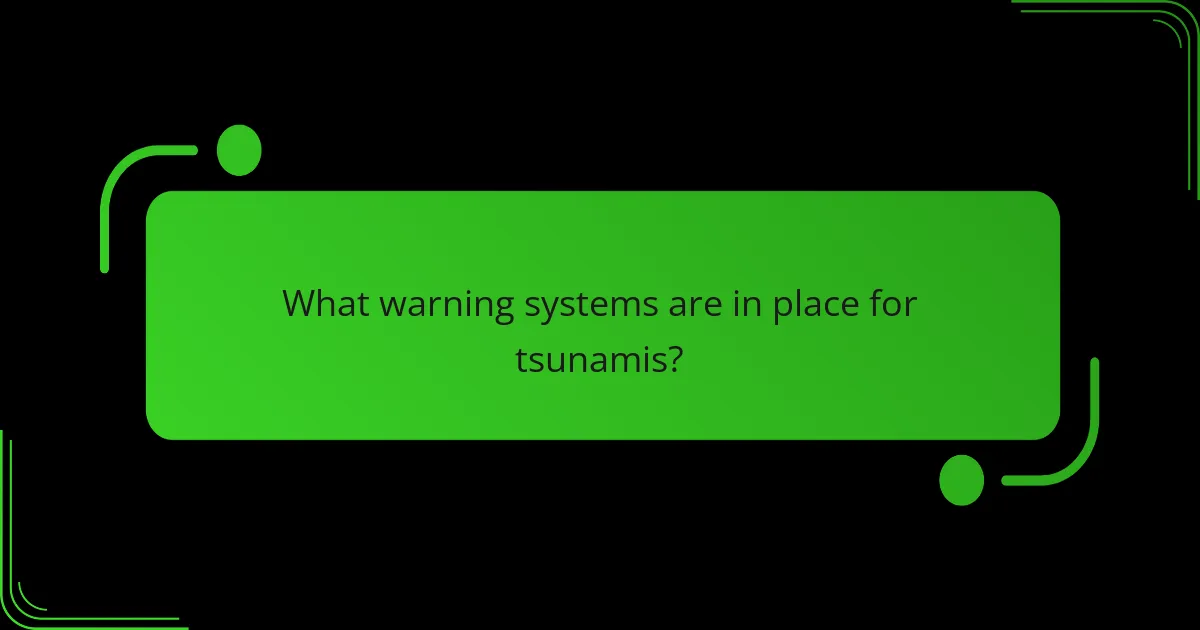
What warning systems are in place for tsunamis?
Tsunami warning systems include seismic monitoring, ocean buoys, and public alert systems. Seismic monitoring detects undersea earthquakes that may generate tsunamis. The National Oceanic and Atmospheric Administration (NOAA) operates a network of seismic stations. Ocean buoys equipped with sensors measure wave heights and transmit data. These buoys are part of the Tsunami Early Warning System. Public alert systems disseminate warnings through sirens, text messages, and media broadcasts. The Pacific Tsunami Warning Center (PTWC) issues alerts for the Pacific region. Historical data shows that these systems have successfully warned populations, reducing casualties during events like the 2004 Indian Ocean tsunami.
How do tsunami detection systems work?
Tsunami detection systems work primarily through a combination of seismic sensors and ocean buoys. Seismic sensors detect underwater earthquakes, which are often the cause of tsunamis. When an earthquake occurs, these sensors send data to monitoring stations.
Ocean buoys equipped with pressure sensors measure changes in sea level. These buoys can identify the presence of a tsunami wave as it passes. The data from seismic sensors and buoys is transmitted to tsunami warning centers.
These centers analyze the information to assess the tsunami’s potential impact. They issue warnings to coastal areas if a tsunami is likely to occur. The effectiveness of these systems was demonstrated during the 2004 Indian Ocean tsunami, where early detection could have saved lives.
What technologies are used in tsunami early warning systems?
Tsunami early warning systems utilize several key technologies. These include seismic sensors, which detect underwater earthquakes that can generate tsunamis. Tsunami buoys are also critical; they measure wave height and transmit data to monitoring centers. Satellite altimetry technology helps in monitoring ocean surface changes. Computer modeling plays a role in predicting tsunami behavior and impact. Additionally, communication systems are essential for disseminating warnings to the public. These technologies work together to provide timely alerts, potentially saving lives during tsunami events.
How is data collected and analyzed to predict tsunamis?
Data is collected and analyzed to predict tsunamis through various methods. Seismographs record seismic activity that may indicate underwater earthquakes. Tsunami buoys measure changes in sea level and pressure. Tide gauges monitor water levels along coastlines. Satellite altimetry provides data on sea surface height variations.
Researchers analyze seismic data to identify earthquake magnitude and depth. They assess the potential for tsunami generation based on these parameters. Numerical models simulate tsunami propagation and impact. Historical data on past tsunamis informs predictive models.
The National Oceanic and Atmospheric Administration (NOAA) operates the Tsunami Warning Centers in the U.S. They utilize this data to issue warnings. These centers rely on real-time data for timely alerts to coastal communities.
What are the challenges of tsunami warning systems?
Tsunami warning systems face several challenges. One major challenge is the detection of tsunamis in real-time. Tsunamis can travel across oceans at high speeds, making timely detection crucial. Another challenge is the accuracy of the data collected. False alarms can lead to public distrust and complacency. Additionally, communication infrastructure can be inadequate in remote areas. This hampers effective dissemination of warnings. Furthermore, there is variability in the response capabilities of different regions. Some areas may lack proper evacuation plans or resources. Lastly, technological limitations can hinder the effectiveness of monitoring systems. These challenges can significantly impact the overall efficiency of tsunami warning systems.
How can false alarms impact communities?
False alarms can significantly disrupt communities by creating unnecessary panic and anxiety. When a tsunami warning is issued falsely, residents may evacuate hastily, leading to chaos and potential injuries. This can strain emergency services and resources, diverting them from actual threats. Furthermore, repeated false alarms can lead to desensitization, causing individuals to disregard future warnings. Studies show that communities experiencing frequent false alarms may suffer from diminished trust in warning systems. For example, a 2011 study by the National Oceanic and Atmospheric Administration highlighted that false alarms can reduce public compliance with evacuation orders. Ultimately, false alarms undermine the effectiveness of emergency preparedness and response efforts.
What limitations do current technologies face in tsunami detection?
Current technologies face several limitations in tsunami detection. One major limitation is the reliance on seismic data, which can delay alerts. Tsunamis can occur without significant seismic activity, making detection challenging. Additionally, existing buoy systems may not cover all oceanic regions, leading to blind spots. False alarms can occur due to the sensitivity of detection systems, causing public distrust. The complexity of ocean dynamics makes it difficult to predict tsunami behavior accurately. Moreover, there is a lack of real-time data integration from various sources, hindering timely responses. Lastly, funding and maintenance of detection systems can be inconsistent, impacting their effectiveness.
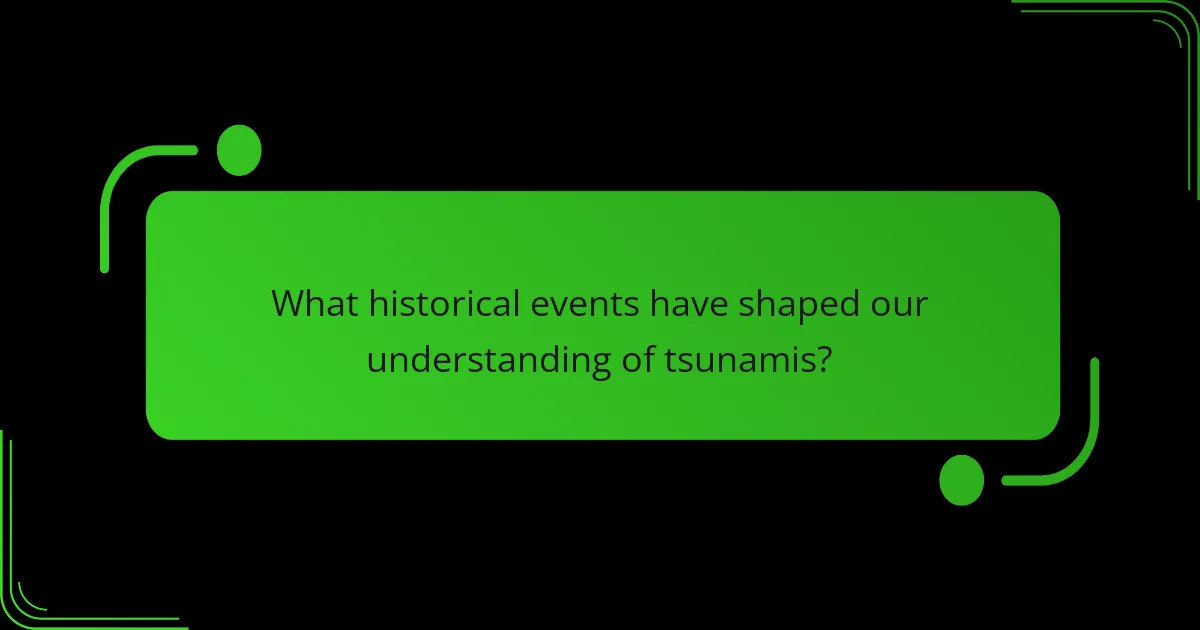
What historical events have shaped our understanding of tsunamis?
Significant historical events have greatly shaped our understanding of tsunamis. The 1700 Cascadia earthquake and tsunami provided early evidence of tsunami generation in the Pacific Northwest. In 1868, a tsunami in Chile revealed the connection between seismic activity and ocean waves. The 2004 Indian Ocean tsunami highlighted the need for global warning systems and better preparedness. This event caused over 230,000 fatalities and prompted international collaboration in tsunami research. The 2011 Tōhoku earthquake and tsunami in Japan further advanced scientific knowledge and response strategies. These events collectively underscored the importance of monitoring and understanding seismic activity to mitigate tsunami risks.
What were the most significant tsunamis in history?
The most significant tsunamis in history include the 2004 Indian Ocean tsunami, the 2011 Tōhoku tsunami, and the 1960 Valdivia tsunami. The 2004 Indian Ocean tsunami occurred on December 26, triggered by a massive undersea earthquake off the coast of Sumatra. It resulted in over 230,000 deaths across multiple countries. The 2011 Tōhoku tsunami struck Japan on March 11, following a 9.0 magnitude earthquake. This event caused widespread devastation and over 18,000 fatalities. The 1960 Valdivia tsunami was generated by the most powerful earthquake recorded, measuring 9.5 on the Richter scale. It affected Chile and caused fatalities as far away as Hawaii and Japan. Each of these tsunamis had profound impacts on coastal communities and led to significant changes in tsunami warning systems and disaster preparedness.
How did the 2004 Indian Ocean tsunami change global awareness?
The 2004 Indian Ocean tsunami significantly increased global awareness of natural disasters. It resulted in over 230,000 fatalities across 14 countries. This catastrophic event highlighted the need for effective tsunami warning systems. Many nations recognized the importance of preparedness and response strategies. The disaster prompted the establishment of the Indian Ocean Tsunami Warning System in 2006. It also raised awareness about the impact of climate change on natural disasters. Media coverage brought the devastation into homes worldwide, fostering a global dialogue on disaster management. The event ultimately led to increased funding for research and technology in tsunami prediction and response.
What lessons were learned from the 2011 Japan tsunami?
The 2011 Japan tsunami highlighted the importance of effective early warning systems. Improved communication protocols are essential for timely evacuations. The disaster emphasized the need for better community preparedness and education. Infrastructure resilience must be prioritized in coastal areas. The event showed the necessity of international cooperation in disaster response. It also revealed the significance of ongoing research in tsunami science. Post-tsunami recovery efforts must include mental health support for affected populations. Finally, the tsunami underscored the importance of regular drills and simulations to enhance readiness.
How have tsunamis influenced policy and preparedness?
Tsunamis have significantly influenced policy and preparedness measures globally. Following major tsunami events, countries have revamped their disaster response strategies. For instance, the 2004 Indian Ocean tsunami led to the establishment of the Indian Ocean Tsunami Warning System. This system enhances regional preparedness through improved monitoring and communication. Additionally, many nations have implemented stricter building codes in coastal areas. These codes aim to minimize damage from future tsunamis. Training and public awareness campaigns have also increased. These initiatives educate communities on evacuation routes and safety protocols. Overall, tsunamis have prompted a comprehensive reevaluation of disaster management policies worldwide.
What changes were made to tsunami response plans after major events?
After major tsunami events, response plans were significantly updated to enhance preparedness and coordination. For instance, following the 2004 Indian Ocean tsunami, many countries improved early warning systems. The United Nations established the Indian Ocean Tsunami Warning and Mitigation System. This system incorporates real-time data sharing and regional cooperation among nations.
Additionally, training programs were developed for local communities to ensure effective evacuation procedures. Countries like Japan revised their tsunami evacuation maps and increased public awareness campaigns. These changes were driven by the recognition of the need for timely communication and community involvement in disaster response.
The lessons learned from these events led to a more robust global framework for tsunami preparedness and response.
How do international collaborations enhance tsunami preparedness?
International collaborations enhance tsunami preparedness by facilitating knowledge sharing and resource allocation. Countries can exchange data on seismic activity and tsunami modeling. This cooperation leads to improved early warning systems. Collaborative training exercises help develop response strategies and protocols. Joint research initiatives advance scientific understanding of tsunami risks. For example, the Pacific Tsunami Warning Center collaborates with multiple nations to enhance regional monitoring. Such partnerships increase the resilience of coastal communities. They also ensure a unified response during tsunami events, ultimately saving lives.
What practical steps can communities take to prepare for tsunamis?
Communities can prepare for tsunamis by developing and implementing comprehensive tsunami preparedness plans. These plans should include establishing early warning systems that can alert residents to imminent tsunamis. Regular tsunami drills and educational programs can enhance community awareness and readiness. Communities should also create evacuation routes and designate safe zones away from the coastline. Infrastructure should be designed to withstand tsunami impacts, and land-use planning should restrict development in high-risk areas. Historical data indicates that communities with proactive preparedness strategies experience lower casualty rates during tsunamis. For example, the 2011 Japan tsunami highlighted the importance of effective warning systems and community drills in minimizing loss of life.
How can individuals create a personal tsunami safety plan?
Individuals can create a personal tsunami safety plan by assessing their risk and establishing clear evacuation routes. First, they should identify if they live in a tsunami-prone area, typically near coastlines or fault lines. Next, they must develop an evacuation plan that includes multiple escape routes to higher ground. It is essential to designate a meeting point for family members after evacuation. Individuals should also prepare an emergency kit with essentials such as food, water, and first-aid supplies. Regularly practicing the evacuation plan ensures that everyone knows what to do during an actual tsunami warning. According to the National Oceanic and Atmospheric Administration (NOAA), having a plan can significantly reduce panic and confusion during emergencies.
What role does community education play in tsunami preparedness?
Community education plays a crucial role in tsunami preparedness. It equips individuals with knowledge about tsunami risks and safety measures. Understanding tsunami warning systems is essential for timely evacuation. Educational programs inform communities about evacuation routes and safe zones. Increased awareness can significantly reduce casualties during an event. Research shows that communities with strong education programs have better preparedness outcomes. For example, the National Oceanic and Atmospheric Administration (NOAA) emphasizes community training to enhance resilience. Overall, effective community education fosters a culture of preparedness and safety.
The main entity of this article is tsunami generation, which encompasses the mechanisms, warning systems, and historical events related to tsunamis. The article details how underwater disturbances such as earthquakes, volcanic eruptions, and landslides trigger tsunamis, emphasizing the role of underwater earthquakes as the primary cause. It explores the characteristics of tsunamis, their differences from regular ocean waves, and the technologies used in tsunami warning systems. Additionally, the article highlights significant historical events that have shaped our understanding of tsunamis and discusses practical steps for community preparedness and individual safety planning.
